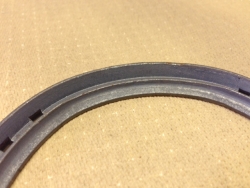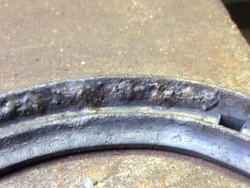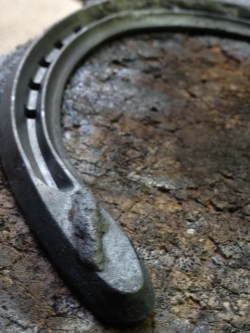 Fig. 1: The steel full wedge shoe, one of the most popular in horse racing.
Fig. 1: The steel full wedge shoe, one of the most popular in horse racing.
The steel full swedge shoe (Fig. 1) is one of the most popular in horse racing.
The swedge is created by forging the shoe into a grooved profile. The higher outer rim defines the tallest grab, or traction device. The shorter inner rim is separated from the outer by a valley, or groove.
When racing on dirt or clay tracks the valley between the two rims of the shoe fills with dirt. This in itself is a traction device. When the dirt held within the shoe meets the dirt of the racetrack, friction is created. This is often enough traction on a dirt track.
On limestone-based tracks, that is sometimes not enough traction. Then the shoe depends on the sharpness of the outer rim for traction. However, when erosion dulls the sharpness of that rim, traction declines. Trying to keep the swedge sharp as long as possible is the concern in this case.
Welding borium to a steel shoe for added traction has been done for many years now. Borium consists of hard carbide grains incased in a softer metal rod. When the softer outer case melts under the torch flame, the carbide grains are released and are welded to the desired surface. This can be done in many ways to increase traction by adding dots, or rims, or a combination.
 Fig. 2: Borium on the inward edge of the outer rim of the swedge, reducing erosion of that rim without adding to the original profile.
Fig. 2: Borium on the inward edge of the outer rim of the swedge, reducing erosion of that rim without adding to the original profile.
Building up grabs by using borium can definitely be overdone, causing lameness.I remember a very nice fellow--who will be nameless--brought a gifted 2-year-old filly to The Red Mile for the Grand Circuit meet. Having raced very well with much borium on the shoes at other limestone tracks, they wanted to keep it that way on the Red Mile clay, much to my concern.
Unfortunately, her racing career did not survive the meet. That is an extreme case, but illustrates the fear many trainers have about using borium or other grabs. This is similar to an article about tracks and traction many months ago, but I want to show some clever ways trainers have used to keep the swedge sharp with borium without adding extra traction.
 Fig. 3: Borium on the inner rim of the shoe. As the outer rim wears down, the inner rim does not form an increased breakover effect.
Fig. 3: Borium on the inner rim of the shoe. As the outer rim wears down, the inner rim does not form an increased breakover effect.
Wilson Witten trained a great pacing filly named Sconce. I remember her well because she was the first world champion I ever shod. “Witt,” as he was often called, was a productive trainer in spite of training a small stable.
Holding a degree in mechanical engineering, Witt liked to tinker with shoeing. One way he came up with to keep the full swedge as sharp as new was to put borium on the inward edge of the outer rim of the swedge (Fig. 2). This reduced the erosion of that rim without adding to the original profile. I must add that I found this to be a difficult welding procedure.
Steve Elliott is a leading trainer who, like many successful trainers, has a keen eye for gait mechanics. He has many times asked me to add borium to the inner rim, bringing it equal to, but not higher than, the outer rim (Fig. 3). I thought this was clever because as the outer rim wears down, the inner rim does not form an increased breakover effect.
 Fig 4: A mild line of borium on the heel to deal with heel erosion and slipping.
Fig 4: A mild line of borium on the heel to deal with heel erosion and slipping.
The reason this is significant is because as the hoof grows, that shoe, and with it breakover, migrates forward, away from the coffin joint. Shoe wear and increased breakover can help reduce that effect. Borium on the inner rim facilitates this.
Dan Shetler is another trainer who gets very involved in shoeing. He likes me to take a new shoe and grind away the toe area. After forging and shaping the shoe, I simply replace the void I made by grinding by adding borium, back to its original height and shape.
He also used a nice idea to deal with heel erosion and slipping. He would have me make a mild line of borium on the heel (Fig. 4). This reduced, but not stopped, the heel sliding when hoof meets track. Stopping that side altogether is when horses get sore.
Many times just keeping the shoe like new for a longer duration will be all that is needed. These are some ways to keep an old shoe looking like new. Now if I could only talk my children into that concept.
Veteran Standardbred farrier Steve Stanley of Lexington, Ky., authors a monthly column for Hoof Beats, the official harness racing publication of the U.S. Trotting Association. The American Farriers Journal Editorial Advisory Board member offers plenty of practical advice that will be of special interest regardless of the type of horses that you work with. Click here to read more from Steve Stanley's Hoof Beats series.








Post a comment
Report Abusive Comment